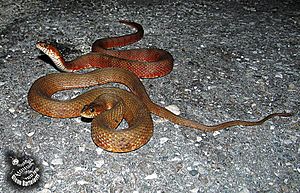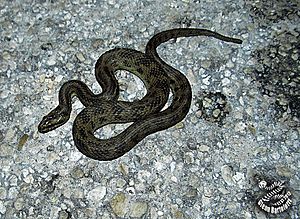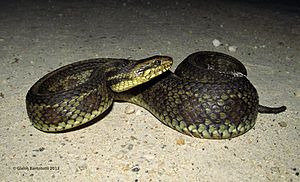Salt marsh snake facts for kids
Quick facts for kids Salt marsh snake |
|
|---|---|
 |
|
| N. clarkii compressicauda, red color phase |
|
 |
|
| N. clarkii compressicauda, normal color phase |
|
| Conservation status | |
| Scientific classification | |
| Genus: |
Nerodia
|
| Species: |
clarkii
|
| Synonyms | |
|
|
The salt marsh snake (also known as Nerodia clarkii) is a type of snake that lives near water. It's not venomous, meaning it's not dangerous. You can find these snakes in the southeastern United States. They live in salty marsh areas along the Gulf of Mexico, from Florida all the way to Texas. There are also some salt marsh snakes in northern Cuba.
Contents
What's in a Name?
The scientific name for this snake, clarkii, was given to honor a person. This person was John Henry Clark (1830-1885). He was an American surveyor and naturalist. A naturalist studies nature.
How to Spot a Salt Marsh Snake
Salt marsh snakes can grow to be about 15 to 30 inches (38 to 76 centimeters) long. They come in many different colors and patterns.
Gulf Salt Marsh Snake
The Gulf salt marsh snake (N. c. clarkii) lives from Corpus Christi, Texas to the Gulf Hammock area of Florida. These snakes are usually gray, tan, or yellow. They have four brown or black stripes running along their bodies.
Mangrove Salt Marsh Snake
The mangrove salt marsh snake (N. c. compressicauda) is found in Florida. You can see them from Tampa Bay south to Miami. They also live north along the Atlantic coast near Cape Canaveral. This subspecies has many different colors and patterns. They can be gray, green, or tan with darker bands. Some are even solid reddish-orange or straw yellow.
Atlantic Salt Marsh Snake
The Atlantic salt marsh snake (N. c. taeniata) lives in a small part of Florida. It is found in Volusia and Indian River Counties. This snake is smaller than the other two types. It has four dark stripes on its neck. These stripes change into dark blotches or bands further down its body. This subspecies is currently listed as a Threatened Species. This means it needs protection to survive.
Snake Family Tree
Scientists group animals into different families. The salt marsh snake belongs to a group called Nerodia clarkii. There are three main types, or subspecies, of the salt marsh snake.
Types of Salt Marsh Snakes
- Nerodia clarkii clarkii – This is the Gulf salt marsh snake.
- Nerodia clarkii compressicauda – This is the mangrove salt marsh snake.
- Nerodia clarkii taeniata – This is the Atlantic salt marsh snake.



